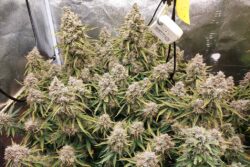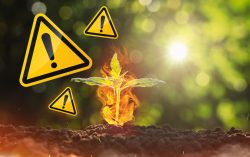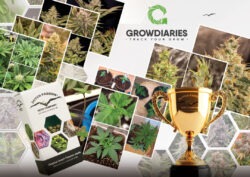Some growers, mainly indoor, may have seen white buds. These are often seen in the plant canopy. Growers with HPS lights can see them, but they are often seen by those with (often new) high powered LED grow lights. The problem is known as cannabis light burn (or weed light burn). It normally isn’t a showstopper and the issue is easy to remedy.
Cannabis plant light burn symptoms and cure
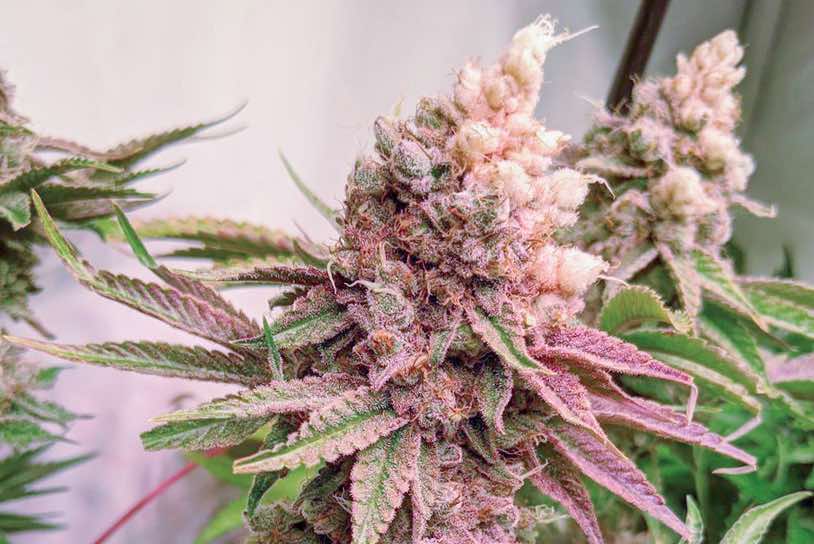
What is cannabis light burn?
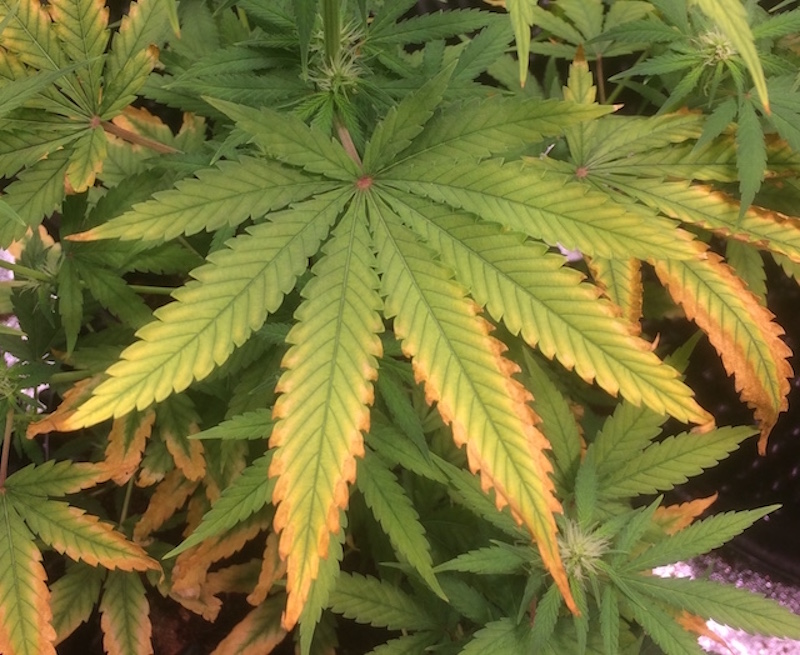
Especially with powerful grow lights, the cannabis plant can be overwhelmed by the combined onslaughts of high PPFD light intensities combined with high temperatures. The result is bleached plant tips that are unable to grow. With the chlorophyll pigment removed, photosynthesis stops in the affected areas.
It should be added that the plant’s ability to cope with e.g. higher light/temperatures can be mitigated if the grow conditions are improved. Pro-growers often add supplemental CO2 (Carbon Dioxide) which allows photosynthesis to continue even at otherwise problematically high light intensities and temperatures. This can be achieved in a variety of ways but bottled & trickle-dosed CO2 or (mycelium CO2 bags) are the main methods.
Although buds with cannabis light burn can have an exotic albino-like appearance the buds are not improved by the bleaching. Any opportunity for the affected buds to grow and swell in their final days/weeks is lost once the cannabis light burn is established. This restricts both potency, bud size and taste.
What are the main factors causing a light burn?
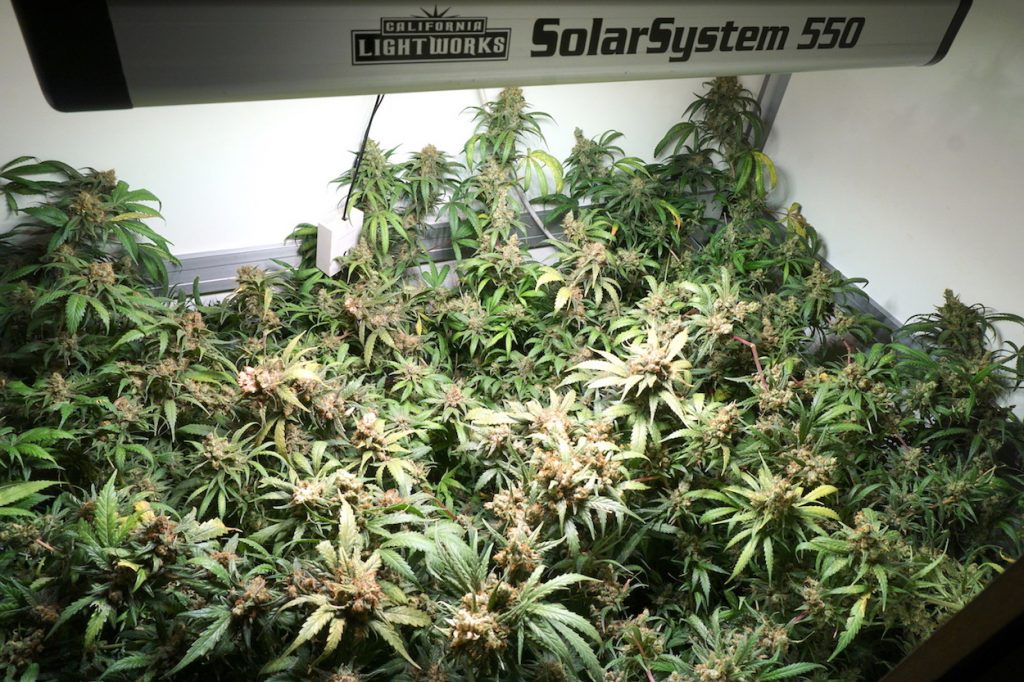
Cannabis light burn tends to affect the uppermost buds in the canopy, often those in the brightest and warmest part of the grow room. It can affect plants grown from either autoflower seeds or feminised cannabis seeds. Optimise your conditions with the right light intensity, ventilation, CO2 levels & temperatures and you shouldn’t see bleached buds.
Light distance / intensity
For most growers the quickest fix if they see cannabis light burn is to raise the height of the grow light immediately or turn down the intensity. Many LED grow lights have a dimmer function.
Competent grow light manufacturers have clear guidelines for LED hanging heights in the cannabis seedling stage, vegetative growth phase and the cannabis bloom stage. These will vary according to the light type (LED bar light vs a point light source), power, fixture efficiency etc.
It’s important to add that the experienced grower can – and should – adapt the rules according to their own experience and judgment. Different strains may respond differently to the same environment, use your own experience to adapt the light hanging height/intensity in a way that gives best results.
Creating a journal, or mental note of hanging height/intensities during your grow is a great way to fine-tune future grows and avoid repeating your errors.
High temperatures
High temperatures in combination with a high light intensity will cause cannabis light burn. Often the highest temperatures are seen in the canopy where the buds are nearest the light.
Many serious growers avoid flowering their cannabis plants during the hottest months if experience tells them that the heat makes indoor growing impractical.
More and more indoor growers are routinely installing air-conditioning to deal with the increased frequency of heat waves. One advantage of air-con for indoor growers is that it allows year-round growing with steady indoor temperatures and consistent quality from harvest to harvest.
Pro Tip: One other option for indoor cannabis growers struggling with summer heat is to set the ‘lights-on’ bloom period to the coolest overnight hours.
Those that are familiar with the process of photosynthesis will note that CO2 can be added to increase the photosynthetic rate. This also allows growers to push their plants a little harder in terms of temperature and light intensity. Most growers simply use atmospheric CO2, but some invest in grow bags of mycelium which release a steady stream of CO2 into their grow room. Ideally, growers should try to keep lights-on temperatures to around (or below) 25 Celsius (77F) and ensure their plants are not exposed to damaging light intensities.
Lack of ventilation
Poor air circulation/ventilation can allow temperature hot spots to occur. These areas are the danger zones for cannabis light burn. As well as ensuring powerful grow room extraction and sufficient fresh/cool air, growers should use clip-on fans around (and below) the canopy level to keep the air moving.
How to detect early signs of light burn on cannabis plants
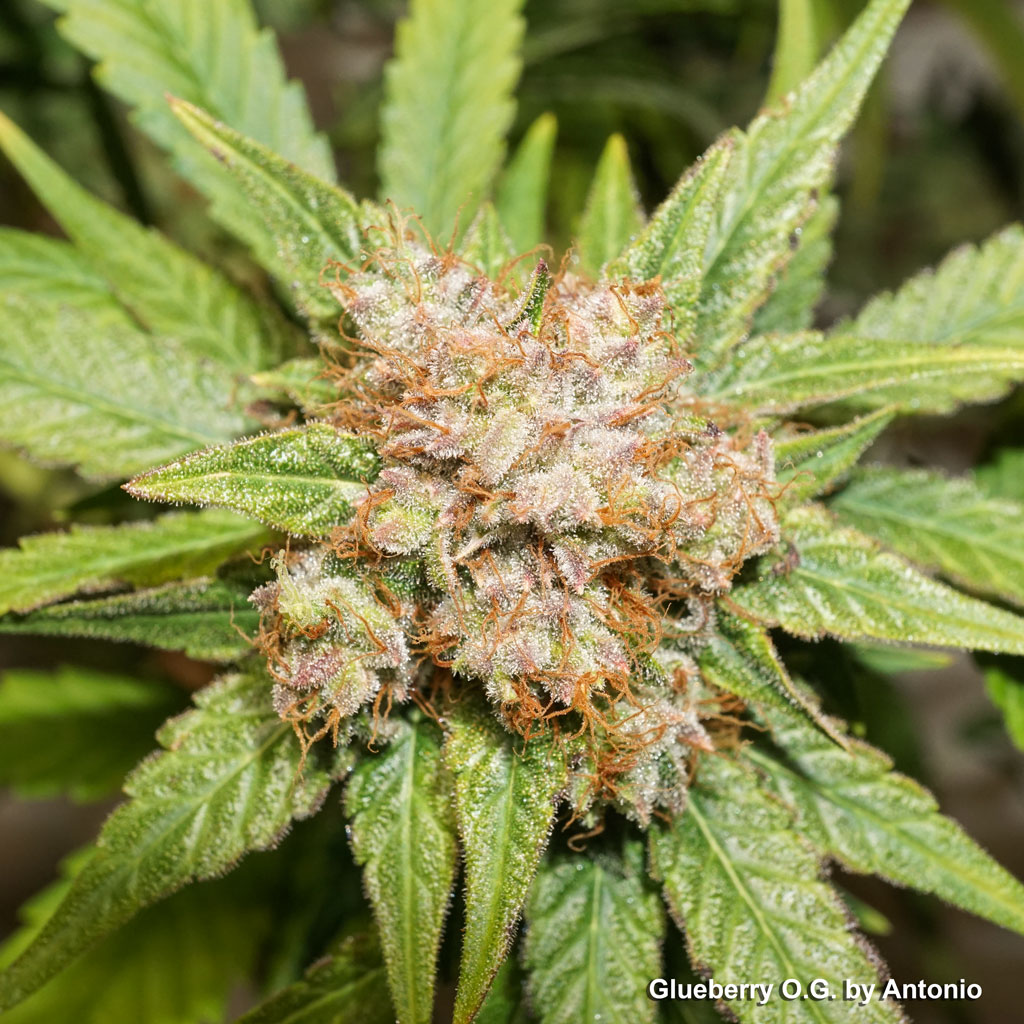
The experienced grower should hopefully already know the limits in terms of their grow light hanging height and respective light setting for their grow room. Less experienced growers may take a grow or two to establish the optimum usage of their LED in their grow room.
Usually, the first signs of cannabis light burn is a slight fade of the normally vibrant green hues on the upper buds. If this is seen, raise the hanging height of the light or decrease the intensity by 10-25%. Monitor and repeat if necessary, until new growth is unaffected. Lower plants areas, especially those in shade will retain a normal appearance despite cannabis light burn on upper areas nearer the light.
Younger cannabis plants can see their growth stunted if they are under excessively strong light. Most modern LED grow lights allow the user to select power levels between 0% -100% and should come with detailed user instructions.
The seasoned grower knows the importance of keeping their cannabis plants in (or near) the optical and nutrient sweet spot. This means that both nutrients and light intensities are at the right levels for vigorous growth. Increase light/nutrient levels too far and the plant becomes stressed, stunting growth. Reduce light/nutrient levels too much and the cannabis plant lacks the energy and minerals for optimised growth.
Cannabis training and the potential to avoid cannabis light burn
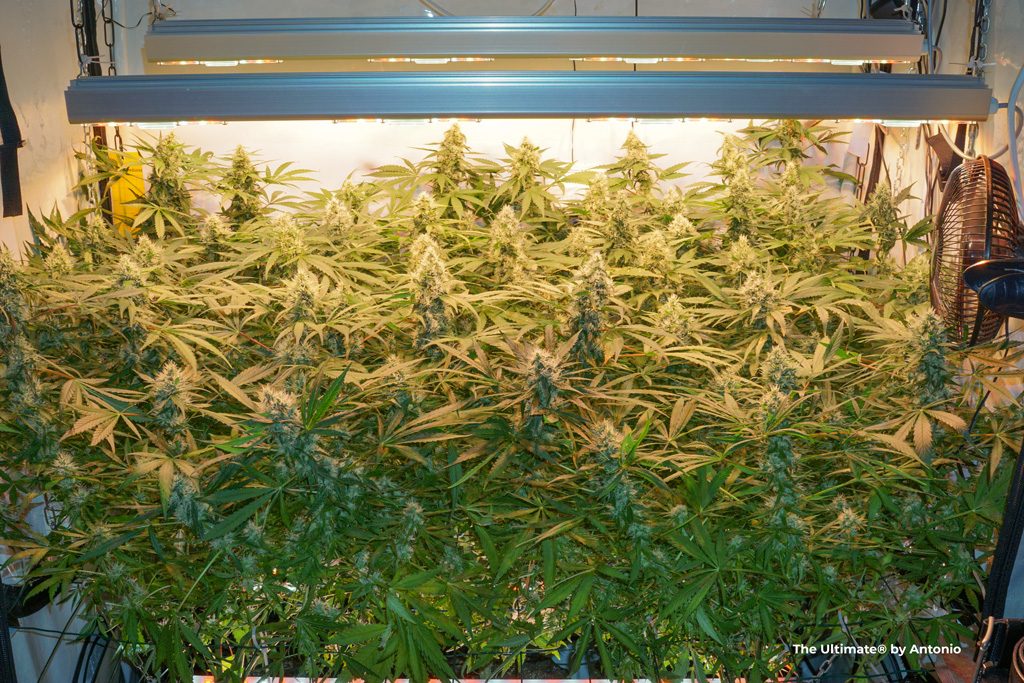
Those familiar with cannabis low stress training (LST) and cannabis high stress training (HST) can use these techniques to great advantage to change the shape/height of their plant. This is particularly useful if you are seeing cannabis light burn and have no free vertical space to raise the hanging height of your light.
Tying down the taller stem/branches (LST) or bending the main stem into a horizontal growth position (known as HST super cropping) can be quick ways to instantly relieve crowding in the upper canopy nearest the light. Likewise growing with the cannabis SCROG method is another option for those keen to keep a canopy of blooms at an equidistant, safe, level from the light.
Cannabis light burn FAQ
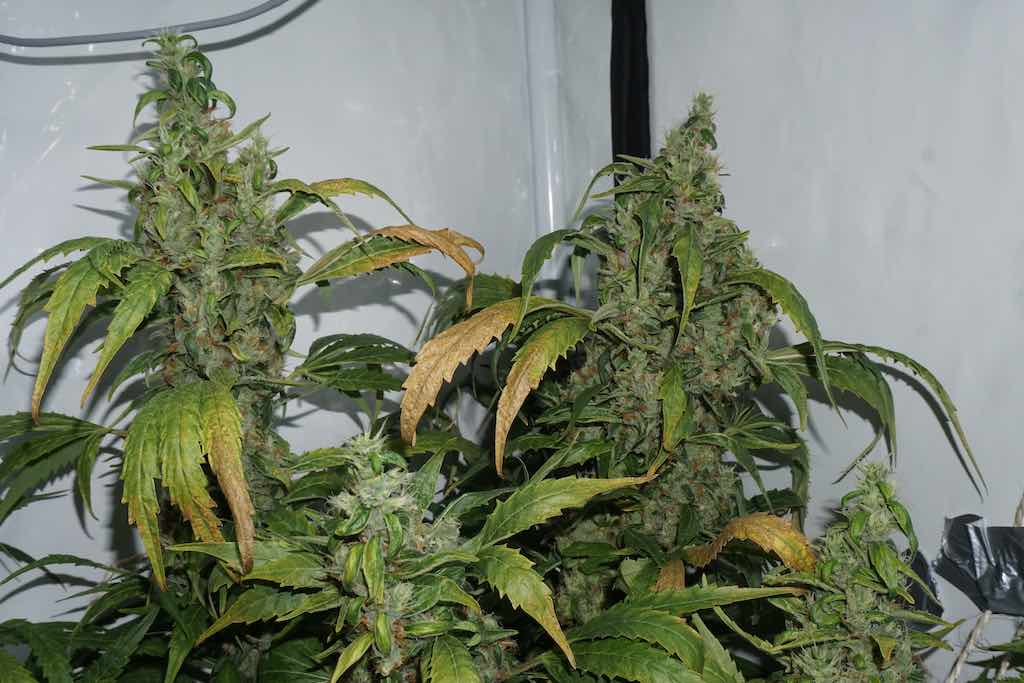
Nutrient burn often expresses itself as scorched, burnt leaf tips. These typically become brown and crispy. Once damaged by nutrient burn both the leaves and the cannabis root system suffer from some degree of damage which may affect final yield/quality. Cannabis light burn is a bleaching process (no ‘browning’).
Yes. Indeed, the crop is harvested normally, and the bleached buds are often set aside as curiosities to impress friends. They are still smokable/vapable, but usually lacking in flavour and may seem slightly less potent. Catch the cannabis light burn early and the damage is minimised, but once bleached the damaged buds can’t recover their green appearance. Nor can they continue photosynthesis. Cannabis light burn requires some period of growth under sub-optimised conditions. The inference for the grower is that harvest quantity and quality may have been compromised somewhat as a result.
Avoidance is always better than cure. Few growers see repeated cannabis light burn, normally they learn from the experience and dial-down conditions for subsequent grows.
Some growers that have upgraded from HPS to a powerful new LED can experience an initially difficult learning curve as they adapt to their new light.
Often the problems are caused by growers trying to test the limits of their new LED, scorching their plants in the process. Sticking to manufacturers hanging-height guidelines is wise, so is avoiding the temptation to push the PPFD light levels too high until your experience increases.
Some growers use light meters to measure PPFD light intensities in the grow room. These are useful, though not necessarily essential or cheap devices. Even those that own light meters tend not to use them daily. Most quickly learn the limits of their grow light and how to use them. For those that get it wrong occasionally, a few bleached buds are not the end of the world. The bulk of the harvest should still be acceptable.
Optimise and monitor your grow room conditions
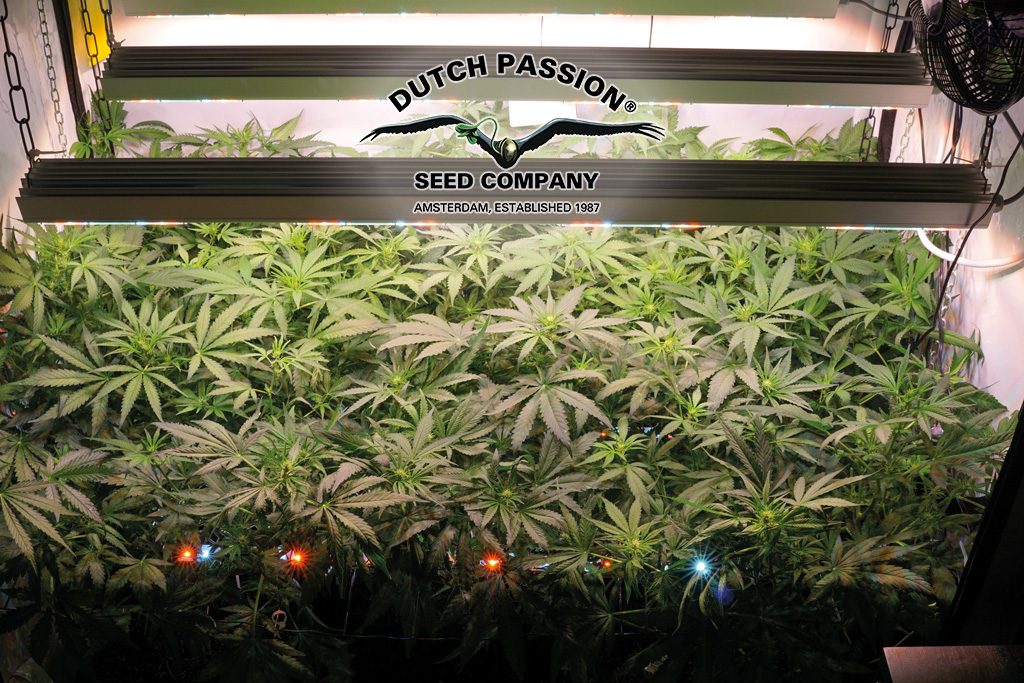
For those indoor growers that feel they are not yet into an established routine with their grow room and light/heat settings, a simple cannabis journal can be a surprisingly valuable guide for future grows. Our recent article on keeping a grow journal explains what you can expect to learn from the process, and contains downloadable forms where you can log week-by-week data. This includes light intensity, light hanging heights etc.
Get the light intensities too low and the plants will stretch excessively. Get the lights too close (and light intensities too high) and you may stunt plant growth or see cannabis light burn. But allow your cannabis plants to grow under optimised conditions and you can expect new levels of growth, yield and quality!


